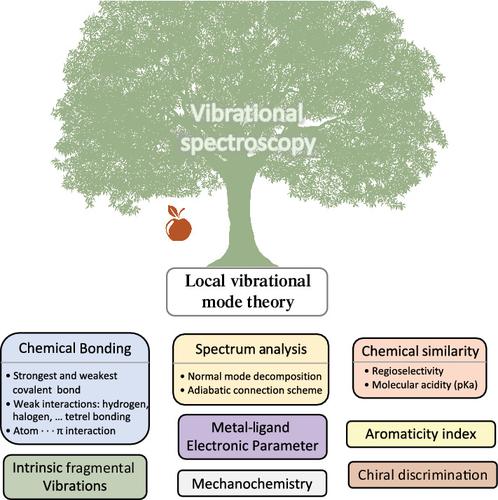当前位置:
X-MOL 学术
›
WIREs Comput. Mol. Sci.
›
论文详情
Our official English website, www.x-mol.net, welcomes your
feedback! (Note: you will need to create a separate account there.)
Decoding chemical information from vibrational spectroscopy data: Local vibrational mode theory
Wiley Interdisciplinary Reviews: Computational Molecular Science ( IF 16.8 ) Pub Date : 2020-05-11 , DOI: 10.1002/wcms.1480 Elfi Kraka 1 , Wenli Zou 2 , Yunwen Tao 1
Wiley Interdisciplinary Reviews: Computational Molecular Science ( IF 16.8 ) Pub Date : 2020-05-11 , DOI: 10.1002/wcms.1480 Elfi Kraka 1 , Wenli Zou 2 , Yunwen Tao 1
Affiliation

|
Modern vibrational spectroscopy is more than just an analytical tool. Information about the electronic structure of a molecule, the strength of its bonds, and its conformational flexibility is encoded in the normal vibrational modes. On the other hand, normal vibrational modes are generally delocalized, which hinders the direct access to this information, attainable only via local vibration modes and associated local properties. Konkoli and Cremer provided an ingenious solution to this problem by deriving local vibrational modes from the fundamental normal modes, obtained in the harmonic approximation of the potential, via mass‐decoupled Euler–Lagrange equations. This review gives a general introduction into the local vibrational mode theory of Konkoli and Cremer, elucidating how this theory unifies earlier attempts to obtain easy to interpret chemical information from vibrational spectroscopy: (a) the local mode theory furnishes bond strength descriptors derived from force constant matrices with a physical basis, (b) provides the highly sought after extension of the Badger rule to polyatomic molecules, (c) and offers a simpler way to derive localized vibrations compared to the complex route via overtone spectroscopy. Successful applications are presented, including a new measure of bond strength, a new detailed analysis of infrared/Raman spectra, and the recent extension to periodic systems, opening a new avenue for the characterization of bonding in crystals. At the end of this review the LMODEA software is introduced, which performs the local mode analysis (with minimal computational costs) after a harmonic vibrational frequency calculation optionally using measured frequencies as additional input.
中文翻译:

从振动光谱数据中解码化学信息:局部振动模式理论
现代振动光谱学不仅仅是一种分析工具。有关分子的电子结构,其键的强度及其构象柔韧性的信息以正常振动模式编码。另一方面,通常的振动模式通常是非本地化的,这阻碍了直接访问此信息的能力,只有通过局部振动模式和相关的局部属性才能实现。Konkoli和Cremer通过质量解耦的Euler-Lagrange方程从势能的谐波近似中获得的基本正态模态中得出局部振动模态,从而为这一问题提供了巧妙的解决方案。这篇综述对Konkoli和Cremer的局部振动模式理论进行了一般性介绍,阐明该理论如何统一较早的尝试以从振动光谱获得易于解释的化学信息的尝试:(a)局部模式理论提供了具有物理基础的力常数矩阵派生的结合强度描述符,(b)提供了广受欢迎的扩展Badger规则适用于多原子分子(c),与通过泛音光谱的复杂路径相比,它提供了一种更简单的方法来导出局部振动。展示了成功的应用,包括新的结合强度测量,红外/拉曼光谱的新详细分析以及对周期性系统的最新扩展,为表征晶体中的结合开辟了新途径。在本文的最后,介绍了LMODEA软件,
更新日期:2020-05-11
中文翻译:

从振动光谱数据中解码化学信息:局部振动模式理论
现代振动光谱学不仅仅是一种分析工具。有关分子的电子结构,其键的强度及其构象柔韧性的信息以正常振动模式编码。另一方面,通常的振动模式通常是非本地化的,这阻碍了直接访问此信息的能力,只有通过局部振动模式和相关的局部属性才能实现。Konkoli和Cremer通过质量解耦的Euler-Lagrange方程从势能的谐波近似中获得的基本正态模态中得出局部振动模态,从而为这一问题提供了巧妙的解决方案。这篇综述对Konkoli和Cremer的局部振动模式理论进行了一般性介绍,阐明该理论如何统一较早的尝试以从振动光谱获得易于解释的化学信息的尝试:(a)局部模式理论提供了具有物理基础的力常数矩阵派生的结合强度描述符,(b)提供了广受欢迎的扩展Badger规则适用于多原子分子(c),与通过泛音光谱的复杂路径相比,它提供了一种更简单的方法来导出局部振动。展示了成功的应用,包括新的结合强度测量,红外/拉曼光谱的新详细分析以及对周期性系统的最新扩展,为表征晶体中的结合开辟了新途径。在本文的最后,介绍了LMODEA软件,











































 京公网安备 11010802027423号
京公网安备 11010802027423号